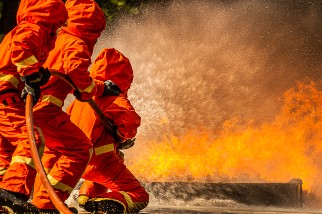Arc-rated flame-resistant (AR/FR) clothing is critical PPE for workers who face flash fire and arc flash hazards. To best safeguard them, an organization must select and properly care for the protective garments they need.
and arc flash hazards. To best safeguard them, an organization must select and properly care for the protective garments they need.
Before you make your next purchase of AR/FR clothing, here are four factors to consider.
1. Know Your Hazards
The first step in selecting the right AR/FR clothing is assessing the hazards workers will encounter. This process will help you determine if AR/FR clothing is necessary. If AR clothing is needed, the hazards in different working environments will determine what category of AR clothing (CAT Rating) is required. The CAT Rating communicates the level of protection a piece of AR clothing provides against injury in the event of an arc flash.
For example, if your workers operate in environments where they could be exposed to a flash fire, FR clothing would be appropriate. If they operate in environments with a potential for an arc flash, they need AR clothing tested for exposure to an electrical arc and given a protective value (arc rating) based on its performance.
“The clothing [a worker] gets should be protective to the hazards [they] face,” says Scott Margolin, vice president of technical at Tyndale Co. Inc. “If there is any possibility of an arc flash hazard, then you need arc-rated clothing and that clothing needs to be appropriate to the incident energy.”
Margolin emphasizes that all AR clothing is also flame-resistant, but not all FR clothing is arc-rated. Ultimately, the goal of AR/FR clothing is to save lives by not igniting and continuing to burn, thereby limiting the body surface area and duration of exposure. The clothing is also designed to insulate workers against second-degree burns.
2. Find a Good Fit
It is also important to give workers comfortable AR/FR garments that fit well.
Margolin says proper fit also enhances safety. If clothing is too loose, it can lead to trips or get caught in machinery. If it is too tight, you eliminate the protective benefit of the air gap and workers can become burned more easily.
“If workers aren’t comfortable and their clothing doesn’t fit well, your compliance goes down, your risk goes up, your liability goes up and if there’s an incident, your costs go up,” he says.
And, while Margolin notes that the choice of a particular style of AR/FR clothing depends on factors such as hazards, end use and wearer preference, employers need to ask several key questions when selecting AR/FR clothing:
- Are FR properties guaranteed for the life of the garment?
- Does the garment risk exposing workers to any toxic or irritating chemicals?
- Does the clothing provide good protection?
- Does it provide effective protection per unit weight?
- Do workers accept or even like how it appears?
Margolin also encourages organizations to offer workers a range of options among approved garments, especially because choice and fit are primary to worker acceptance of the PPE.
“If you give workers choice (in clothing), they are more likely to wear it, wear it properly, wear it when they are supposed to and take care of it so it lasts longer.” he says.
He adds that allowing workers to use direct purchase programs provides them further agency in selecting and wearing want they want when they want, and access to innovative new products as they enter the market.
3. Look at Labels
When selecting and purchasing AR/FR clothing, you want to select items that meet industry standards for the hazards your workers will face.
“Make sure what you’re buying has labels in the right place to cover the standards that are appropriate for your hazards,” he says.
Several standards apply to different types of FR or AR testing. These include:
- NFPA 2112 – Flash fire
- ASTM F1506 (for NFPA 70E) - Arc flash
- ANSI 107 – High visibility
- ASTM F1891 – Arc flash rainwear
- ASTM 2733 – Flash fire rainwear
- ASTM F1959 – Arc rating
In addition, since most AR/FR clothing has multiple labels, Margolin advises you assess the entire garment. For example, a shirt may have labels in the sleeve, the neck, the tail or on the outside. Locate and review all the labels to confirm the clothing complies with hazards your workers face.
4. Care for the Clothing
Like any PPE, you want to maintain AR/FR clothing so that it will continue to provide an appropriate level of protection. OSHA 1910.269 states that employers are responsible for maintaining PPE, yet no agency standard mandates a specific laundering process. Margolin points to two ASTM documents that offer guidelines for AR/FR laundering:
As Margolin notes, whether your organization uses an industrial laundering service or prefers home laundering, no bleach or fabric softeners should be used. It’s also important to recognize, Margolin explains, that even if your organization uses a third-party service to launder AR/FR clothing, you are responsible for ensuring the clothing is clean, in good repair and appropriate for the work being performed.
View our free webinar sponsored by Tyndale to learn more about AR and FR clothing.
Understanding Risk Management and Assessment
We have the resources and expert guidance you need to improve how you assess risks to prevent hazards, protect workers and safeguard equipment.
Learn more